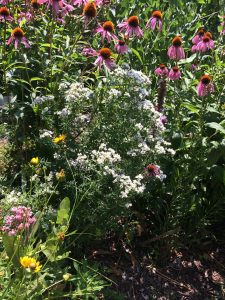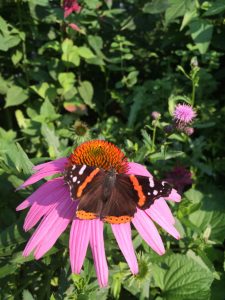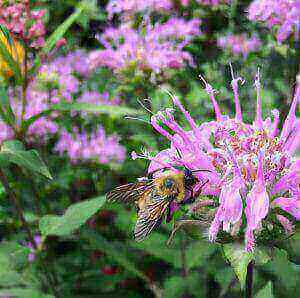Native Gardening Basics
There are many ways to start using native plants in your garden. You can start to incorporate native plants into your existing landscape or – you can start completely from scratch.
First, make an assessment of the environmental conditions (shady or sunny, drainage, soil types, irrigation, etc.). Also, make an inventory o f your existing plants.
f your existing plants.
It is also helpful when creating a naturalistic landscape design to consider the associations found in specific plant communities (a prairie, wetland or forest). You may also want to visit some local natural areas to observe these associations first-hand.
Planning and planting a native garden does not have to be done all at once. It can be installed in phases as your budget and time allows.
Soil Preparation
If weeds are a big problem, you may want to consider not only hand-pulling, but maybe even covering them with a sheet of clear plastic for several months a process known as solarization. Other methods to kill weeds are pouring boiling water or vinegar on them. By eliminating weeds first, as much as possible, before planting, it will be much easier than trying to control them in a newly planted site. Just as a note, methods that involve solarization, vinegar, boiling water may also kill the beneficial life in the soil. If you use those methods, allow some time for pH of the soil to return to normal and consider adding good compost or healthy soil from other areas of your garden to help repopulate your soil with beneficial microorganisms.
The easiest method to start a new garden is to use sheet composting or lasagne bed, which is simply layering browns and greens on a bed of cardboard, in the fall. First make sure you have mown the area. Place down cardboard and wet it thoroughly. Then place a layer of leaves, then a layer of greens (lawn clippings are great), and so on till you have a pretty think bed. Water these layers. Add a layer of mulch on top. Over the fall, winter, and spring, all of the decomposers in the soil will be working and by late spring you can plant into your new garden. All of the ingredients may not be thoroughly composted, but they are usually enough so that you can plant. As the temps warm up, the materials will be consumed and turned into soil soon enough.
Plant Selection and Plants
Choose species based on the soil, light, and water conditions of your site and for the size, shape, texture, and color you desire.
Suggested Prairie Plants (full sun):
Spring:
Spiderwort, Golden Alexanders, Prairie Smoke, Prairie Phlox, Cream Prairie Indigo
Summer:
Purple Prairie Clover, Purple Coneflower, Black-eyed Susan, Butterflyweed, Culvers Root,
Fall:
New England Aster, Smooth Blue Aster, Stiff Goldenrod, Showy Goldenrod, Aromatic Aster
Grasses:
Little bluestem, Big Bluestem, Prairie Dropseed, Indian grass, Switch Grass, Purple Love Grass
Suggested Woodland Plants (shade):
Spring:
Wild geranium, Virginia Bluebells, Wild Columbine, Celadine Poppy, Jacob’s Ladder, Early Meadow Rue
Virginia Water Leaf, Wild Blue Phlox, Columbine 
Ferns:
Marginal Shield fern, Ostrich Fern, Christmas Fern
Groundcovers:
Wild Ginger, May Apple, Allegheny Foam Flower
Three-Season Plants:
Solomons Seal, Solomons Plume, White Baneberry
Fall:
Shorts Aster, Large-leaf Aster, Elm-leaved Goldenrod, Zig-zag Goldenrod, Blue-stemmed Goldenrod,
Blue Mist, White Snakeroot (can be a prolific self-seeder, grows smaller in shady situations)
Shrubs:
Hazelnut, Witch Hazel, Arrowwood Viburnum, Pagoda Dogwood
Maintaining Your Landscape
Your native plants will need time to become established. The critical period for watering and weeding is two to three weeks after planting or longer if you are planting in warm, dry seasons. If you are planting trees or shrubs, apply a four to six-inch layer of organic mulch around them (but, not touching the main stem) and a one-inch or less mulch layer for perennials. Mulch can help control weeds, reduce temperature fluctuations, help retain moisture and give a finished look to the landscape. Native plants usually do not require fertilizer. Many thrive in poor soil and applying fertilizer could chemically burn them, or stimulate either lush or spindly, weak foliage growth with few flowers. Leaving the organic matter in the fall and spring is all you need to do. This material will feed the soil organisms which will then feed your plants. Fungi are critically important for the health of your plants, and they prefer whole material to consume.
Enjoy the butterflies and birds that visit. Each year add more native plants. Make more prairie and/or woodland spaces. Educate your neighborhood by example! Once you get started, it becomes easier and easier every year to maintain your property/grounds — less mowing and watering; more wildlife and soil improvement.

